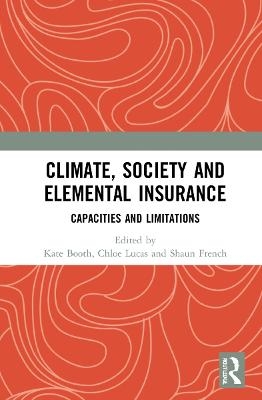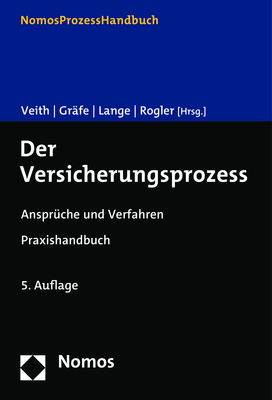
Climate, Society and Elemental Insurance
Routledge (Verlag)
978-0-367-74386-4 (ISBN)
In this book, world-leading social scientists come together to provide original insights on the capacities and limitations of insurance in a changing world.
Climate change is fundamentally changing the ways we insure, and the ways we think about insurance. This book moves beyond traditional economics and financial understandings of insurance to address the social and geopolitical dimensions of this powerful and pervasive part of contemporary life. Insurance shapes material and social realities, and is shaped by them in turn. The contributing authors of this book show how insurance constitutes and is constituted through the traditional elements of earth, water, air, fire, and the novel element of big data. The applied and theoretical insights presented through this novel elemental approach reveal that insurance is more dynamic, multifaceted, and spatially variegated than commonly imagined.
This book is an authoritative source on the capacities and limitations of insurance. It is a go-to reference for researchers and students in the social sciences – particularly those with an interest in economics and finance, and how these intersect with geography, politics, and society. It is also relevant for those in the disaster, environmental, health, natural, and social sciences who are interested in the role of insurance in addressing risk, resilience, and adaptation.
The Open Access version of this book, available at www.taylorfrancis.com, has been made available under a Creative Commons Attribution-Non Commercial-No Derivatives 4.0 license.
Kate Booth is a human geographer, specializing in the field of critical insurance studies. She is particularly interested in the economic and social geographies of insurance in a changing climate, and implications for inequality and inequity. Kate has also worked on projects looking at sense of place, and the role of arts and culture in urban regeneration. Her work is published in journals such as Progress in Human Geography, Environment and Planning A: Economy and Space, Environment and Planning E: Nature and Space, Urban Studies, and Qualitative Inquiry. Chloe Lucas is a human geographer at the University of Tasmania. A communications specialist, she began her career making documentaries about science and landscape history for the BBC. Chloe’s research explores the values and experiences underlying different social responses to climate change, and identifies pathways to more empathetic and inclusive climate conversations. Her recent work focusses on how communication and cultural context drives social adaptation to extreme weather events, and can be found in journals including Climatic Change, Environment and Planning E: Nature and Space, Geographical Research, and WIRES Climate Change. Shaun French is an Associate Professor in Economic Geography at the University of Nottingham. He focuses on the geographies of economic practice and knowledge, specifically financial services and money, socially responsible investment, and financial centres. As part of the University’s Rights Lab, he is developing new work on debt, vulnerability and anti-money laundering.
List of Tables
List of Figures
List of Contributors
Acknowledgement
Chapter 1. Introduction
Kate Booth
Section I. Earth
Chapter 2. Insurance and geoengineering: From the delusional to the terrestrial?
Lauren Rickards
Chapter 3. Indexing the soil
Olli Hasu and Turo-Kimmo Lehtonen
Chapter 4. Renaturalising sovereignty: Ex-ante risk management in the Anthropocene
Kevin Grove
Section II. Water
Chapter 5. Stopping the flow: The aspirational elimination of cross-subsidies in the United States and the United Kingdom
Rebecca Elliott
Chapter 6. After the flood: Diverse discourses of resilience in the United States and Australia
Chloe Lucas and Travis Young
Chapter 7. Flood insurance: A governance mechanism for supporting equitable risk reduction and adaptation?
Mark Kammerbauer and Christine Wamsler
Section III. Fire
Chapter 8. Between absence and presence: Questioning the value of insurance for bushfire recovery
Scott McKinnon, Christine Eriksen, and Eliza de Vet
Chapter 9. Is fire insurable? Insights from bushfires in Australia and wildfires in the United States
Kenneth S. Klein
Chapter 10. Fire insurance and the ‘sustainable building’: The environmental politics of urban fire governance
Pat O’Malley
Section IV. Air
Chapter 11. The relational urban geographies of re/insurance: Florida hurricane wind risk and the making of Singapore’s catastrophe finance hub
Zac J. Taylor
Chapter 12. Emotions and under-insurance: Exploring reflexivity and relations with the insurance industry
Nick Osbaldiston
Chapter 13. Insure the volume? Sensing air, atmospheres and radiation in the Chernobyl Exclusion Zone
Christine Eriksen and Jonathon Turnbull
Section V. Big data
Chapter 14. The uncertain element: Personal data in behavioural insurance
Maiju Tanninen, Turo-Kimmo Lehtonen, and Minna Ruckenstein
Chapter 15. Insurance, insurtech, and the architecture of the city
Liz McFall
Chapter 16. Conclusion: Deconstructing the dualisms of elemental insurance
Chloe Lucas
Index
| Erscheinungsdatum | 23.05.2022 |
|---|---|
| Zusatzinfo | 2 Tables, black and white; 3 Line drawings, black and white; 7 Halftones, black and white; 10 Illustrations, black and white |
| Verlagsort | London |
| Sprache | englisch |
| Maße | 156 x 234 mm |
| Gewicht | 453 g |
| Themenwelt | Naturwissenschaften ► Biologie ► Ökologie / Naturschutz |
| Naturwissenschaften ► Geowissenschaften ► Geologie | |
| Naturwissenschaften ► Geowissenschaften ► Geophysik | |
| Betriebswirtschaft / Management ► Spezielle Betriebswirtschaftslehre ► Versicherungsbetriebslehre | |
| Wirtschaft ► Betriebswirtschaft / Management ► Unternehmensführung / Management | |
| ISBN-10 | 0-367-74386-8 / 0367743868 |
| ISBN-13 | 978-0-367-74386-4 / 9780367743864 |
| Zustand | Neuware |
| Haben Sie eine Frage zum Produkt? |
aus dem Bereich


